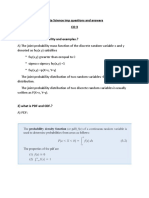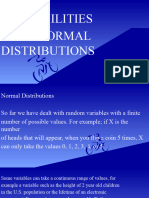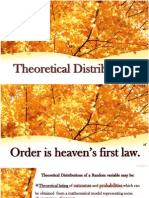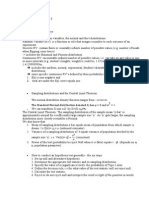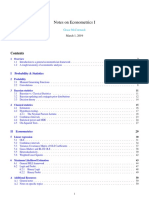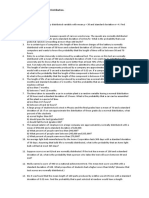Continuous and Random Variables
Uploaded by
SimeonContinuous and Random Variables
Uploaded by
SimeonContinuous random variables and probability distributions
DC-1
Semester-II
Paper-III: Statistical Methods in Economics-I
Lesson: Continuous random variables
And probability distributions
Lesson Developer: Chandra Goswami
College/Department: Department of Economics,
Dyal Singh College, University of Delhi
Institute of Lifelong Learning, University of Delhi 1
Continuous random variables and probability distributions
TABLE OF CONTENTS
Section Number and Heading Page
Number
Learning Objectives
1. Continuous random variables
2
2 Probability distributions for continuous random variables
4
3. Cumulative distribution functions for continuous random variables
11
4. Deriving probability densities from cumulative distribution functions
14
5. Percentiles of a continuous distribution
16
6. Shape of the probability distribution
17
Practice Questions
20
Reference
Jay L. Devore: Probability and Statistics for Engineering and the Sciences,
Cengage Learning, 8th edition [Chapter 4]
CONTINUOUS RANDOM VARIABLES AND PROBABILITY DISTRIBUTIONS
Learning objectives:
In this chapter you will learn what is meant by a continuous random variable. You
will learn how to arrive at the probability distribution of such types of random
variables and how to represent these graphically, as well as presentation by
summary expressions. You will then learn how to derive cumulative distribution
Institute of Lifelong Learning, University of Delhi 2
Continuous random variables and probability distributions
functions from the probability distribution function. You will also be able to derive
the probability densities from the cumulative distribution function. If either the
probability density function or the cumulative distribution function is known then
you will be able to evaluate the probability that the random variable takes on
specific values or a range of values. You will also learn how to identify the
characteristics of the population distribution like the shape of the distribution.
Chapter Outline
1. Continuous random variables
2. Probability distributions for continuous random variables
3. Cumulative distribution functions for continuous random variables
4. Deriving probability densities from cumulative distribution functions
5. Percentiles of a continuous distribution
6. Shape of the probability distribution
1 CONTINUOUS RANDOM VARIABLES
A random variable is said to be continuous when the outcome of a random
experiment can be any real number in a given interval and the number of
possibilities is uncountably infinite. The outcomes of experiments are denoted by
points on a line or on line segments of the measurement axis.
Example 1.1
Students of a college are given an objective type test. The proportion of correct
answers that a student scores in the test is a continuous variable which can range
from 0 to 1. Measured as a percentage, the outcome varies from 0 to 100
percent.
Example 1.2
A student travels to college by metro. The frequency of trains in the morning is 4
minutes. If the student reaches the platform as one train is departing she will
have to wait for 4 minutes till the next train enters the station. If she reaches just
as one train enters the station then she will have to wait 0 minutes to board the
train. If she reaches after the earlier train has left and the next train is yet to
arrive, she will have to wait for a time period between 0 and 4 minutes. Waiting
time is a continuous variable with a minimum of 0 minutes and a maximum of 4
minutes.
Institute of Lifelong Learning, University of Delhi 3
Continuous random variables and probability distributions
Example 1.3
The daily consumption of water (in liters) by an individual at home varies from
day to day through any given year. It depends on various factors like amount of
time spent at home, weather conditions, time of year, how much of the time
spent at home is during waking hours, etc. The unit of measurement is a
continuous variable with a minimum value of 0 liters.
Definition 1
A random variable is continuous if both the following conditions apply
1. Its set of possible values consists either of all numbers in an interval on
the number line or all numbers in a disjoint union of such intervals.
2. No possible value of the random variable has a positive probability.
Condition 1 implies that there is no way to create a listing of all the infinite
number of possible values of the variable. Condition 2 implies that intervals of
values have positive probability. As the width of the interval diminishes,
probability of the interval decreases. In the limit, probability of the interval is zero
as the width of the interval reduces to zero.
Example 1.4
The university team is scheduled to visit any minute during a three hour long
examination starting at 9am. We may want to find the probability that the team
visits at a given time or we may be interested in the probability that the visit
takes place during a given time interval. The sample space is from 0 to 180
c
minutes. The probability that the team visits during an interval of length c is .
180
This assignment of probabilities applies only to intervals on the measurement axis
from 0 to 180. The probability decreases as the interval becomes shorter. For an
5
interval of 5 seconds, the probability is computed as 0.0004629 As the
10800
length of the interval approaches zero, the probability that the team will visit also
approaches zero. That is why we always assign zero probability for a single point
on the number line. This does not mean that the team will not visit. The team will
visit at some point in the interval from 0 to 180 minutes even though each point
has zero probability.
Variables such as time, height, distance, temperature, area, volume, weight, etc
that require measurement are continuous. In practice, however, limitations of
Institute of Lifelong Learning, University of Delhi 4
Continuous random variables and probability distributions
measurement instruments often do not allow measurement on a continuous
scale. Yet we study models of continuous variables as they often reflect real world
situations.
2 PROBABILITY DISTRIBUTIONS FOR CONTINUOUS RANDOM
VARIABLES
Whereas the set of possible values of a discrete rv is a sequence, the set of
possible values for a continuous rv is an interval. The continuous rv X can take
any one of the infinite number of possible values in that interval. In this case
random variables can take on values on a continuous scale.
To derive the probability distribution for a continuous rv let us first begin with a
discrete rv. Let X be a discrete rv which can take integer values such that x 1 < X
< xn, where x1 and xn are the minimum and maximum values respectively of the
rv X.
If x = x1, x2, …., xn then we can draw a probability histogram with n rectangles.
The area of the rectangle centered at xj is the proportion of the population that
fj
has the value xj, ie, where N is the population size. Summing over the n
N
n
fi
values of X we obtain N
i 1
1
Now we allow X to take one additional value in each interval so that x 1’ is midway
between x1 and x2; x2’ is midway between x2 and x3; and so on. Then total
number of x values will be 2n – 1 (instead of 2n, as there are n - 1 intervals).
With measurements of x taken at smaller intervals, the rectangles become
narrower, though the sum of the areas of all rectangles remains one.
If we continue this process of measuring x at smaller and smaller intervals, the
resulting sequence of probability histograms, of the distributions of corresponding
discrete random variables, will approach a smooth curve. Figure 1 illustrates this
process in the three panels 1.1, 1.2 and 1.3
Figure 1 Deriving histogram of a continuous random variable
Institute of Lifelong Learning, University of Delhi 5
Continuous random variables and probability distributions
Fig 1.1 Histogram of a discrete random variable
Fig 1.2 Histogram of the discrete random variable with
measurements taken at smaller intervals
Fig 1.3 Limit of a sequence of discrete histograms
Since for each histogram the total area of all rectangles equals one, the total area
under the continuous curve is also one. The smooth curve represents a
continuous probability distribution. The sum of the areas of the rectangles that
represent the probability that X falls within any specified interval [a, b]
approaches the corresponding area under the curve for the interval from a to b.
Definition 2
Let X be a continuous random variable. Then a probability distribution or
probability density function (pdf) of X is a function f(x) such that for any two
b
numbers a and b with a < b, P(a < X < b) = f ( x) dx
a
Probability density functions are also referred to as density functions.
The probability that X takes on a value in the interval [a, b] is the area under the
graph of the density function above the interval [a, b] on the number line.
Institute of Lifelong Learning, University of Delhi 6
Continuous random variables and probability distributions
The following two conditions must be satisfied by f(x) to be a pdf:
1. f(x) > 0 for -∞ < x < ∞
2. f ( x) dx 1
The first condition requires non-negative values of pdf for any x value. The
second condition requires that area under the entire curve of f(x) should equal
one, ie X values are collectively exhaustive. If all possible values of X are
considered then the second condition will be satisfied. Examples of pdf are the
continuous Uniform Distribution, the Normal Distribution, the Exponential
Distribution, etc.
Unlike the pmf, where we can obtain P(X = c) as the probability that the discrete
rv X takes the value c, the probabilities for a continuous rv are always associated
with intervals. The pdf yields P(X = c) = 0 for any particular value of the rv X.
This follows from the definition of a continuous rv as specified in condition 2 of
definition 1.
For the discrete rv X, each possible value of X is assigned a positive probability.
In case of the continuous rv X, area under the density curve that lies above any
single value of X is zero. We have:
c c
P(X=c) = p(c) = f ( x) dx lim f ( x) dx 0
c
0
c
In view of this property, it does not matter if we include or we exclude the
endpoints of the interval from a to b. Thus, for the continuous rv X, if a < b,
P(a < X < b) = P(a < X < b) = P(a < X < b) = P(a < X < b).
This is not the case with discrete random variables. If both a and b are possible
values of the discrete rv X then these probabilities will all be different. If a < b,
then for the discrete rv X,
P(a < X < b) ≠ P(a < X < b) ≠ P(a < X < b) ≠ P(a < X < b).
Example 2.1
A milk vendor has a refrigerated storage tank of 1000 liters capacity, which is
filled each morning for sale during the day. It is not possible to predict the
amount of milk sold on any particular day. The sale of milk on any day can vary
from 0 lt. to 1000 lt. Past experience shows that any demand in the interval of 0
Institute of Lifelong Learning, University of Delhi 7
Continuous random variables and probability distributions
and 1000 is equally likely. The rv X indicates the sale of milk on a particular day.
The pdf of X is given by the continuous Uniform Distribution
0.001 0 x 1000
f(x) =
0 otherwise
In general, if α and β are the lower and upper limits of the value that the
continuous rv X can take, then pdf of X is
1
0 x 1000
f(x; α, β ) =
0 otherwise
The probability of an interval depends only on the width of the interval in case of
the uniform distribution.
The pdf of the uniform distribution is illustrated in Figure 2.
Figure 2 Graph of the continuous Uniform Distribution
1
In our example, β – α = 1000 so that = 0.001. We can use this to obtain
the probability that sale of milk on a particular day is between 200 and 500 liters
as follows:
P(200 < X < 500) = (500 – 200)(0.001) = 0.3
Note that α and β are the parameters of a population of the continuous rv X that
is described by a uniform distribution. We have a family of uniform distributions
for different values of the two parameters. Each distribution is specified by a
particular pair of values of α and β.
Exercise 1
Show that f(x) = 3x2 for 0 < x < 1 represents a pdf and calculate P(0.1 < x <
0.5).
Institute of Lifelong Learning, University of Delhi 8
Continuous random variables and probability distributions
Solution
f(x) can represent a pdf if both conditions for a pdf are satisfied, ie, f(x) > 0 and
f ( x) dx 1 .
Since f(x) = 3x2 and x2 > 0 always, hence f(x) > 0 for all x values. Therefore,
for 0 < x < 1, f(x) > 0 and the first condition is satisfied.
1 1
3x 3
3x
2
dx = = 1 – 0 = 1, which satisfies the second condition for pdf.
0 3 0
Since both conditions are satisfied, f(x) = 3x 2 represents a pdf for 0 < x < 1
0. 5
Now, P(0.1 < x < 0.5) =
3x dx = (0.5)3 – (0.1)3 = 0.125 – 0.001 = 0.124
2
0 .1
Example 2.2
e x x0
The pdf for a continuous rv is given as f(x) =
0 x0
So that as x value increases from x = 0, f(x) decreases rapidly or exponentially,
as illustrated in Fig 3
Figure 3 pdf of f(x) = e- x for x > 0
e
x
Now, P(a < X < b) = dx. This is the shaded area in figure 3.
a
If a = 2 and b = 5, then
5 5
e x
e
x
P(2 < X < 5) = dx = 2 = - (0.006738 – 0.135335) = 0.128597 =
2
0.13
Therefore, 13 percent of the area under the curve of f(x) = e- x
lies above the
measurement axis in the interval [2, 5].
Institute of Lifelong Learning, University of Delhi 9
Continuous random variables and probability distributions
Exercise 2
Show that f(x) = e- x for 0 < x < ∞ represents a pdf, and compute the probability
that
X > 1.
Solution
f(x) = e -x
would represent a pdf if f(x) > 0 and f ( x) dx 1 for 0 < x < ∞
0
Since e > 0, for all positive x values e-x > 0.
f(x) = 1 for x = 0. If x> 0, f(x) < 1. As x → ∞, f(x) → 0
e x
f ( x) dx e
x
= dx = 0 = [0 – 1] = 1.
0 0
Thus both conditions are satisfied and f(x) is a pdf.
e
x
P(X > 1) = dx = - [ 0 – e- 1] = e-1 = 0.368
1
Exercise 3
The pdf of the rv X is given by
k
0 x4
f ( x) x
0 otherwise
Find (a) the value of k, and (b) P(X > 1)
Solution
4
k
(a) Given that f(x) is a pdf we have
0 x
dx 1
4 4
4 k x 1
Now
0 x
dx
12
= 2k [2 – 0] = 4k. Equating 4k and 1 we get k = 4 so
0
1
that f(x) =
4 x
4 4
2 x 1
P(X > 1) =
1 1
(b) dx = 1 - 2 = 2 = 0.5
1 4 x 4 1
Exercise 4
Institute of Lifelong Learning, University of Delhi 10
Continuous random variables and probability distributions
If the continuous random variable X can take only non-negative values and has
the density function f(x) = e2x for x > 0, and 0 otherwise, what is the maximum
value of X?
Solution
e dx 1
2x
If f(x) is a density function then for x > 0, and 0 otherwise.
0
x x
e2 y e2 x 1
0 1 e2x = 3
2y
e dy
2 0
2 2
Therefore, 2x = ln 3 = 1.0986, so that x = 0.549
Hence, f(x) will be a density function for 0 < x < 0.549. Maximum value of X is
0.549
3 CUMULATIVE DISTRIBUTION FUNCTIONS FOR CONTINUOUS
RANDOM VARIABLES
Similar to the case of discrete random variables, there are many problems where
we need to know the probability that a continuous rv X takes a value that does
not exceed a specified value x. For this we need the cumulative distribution
function (cdf) of X.
Definition 3
If X is a continuous random variable then the cumulative distribution function
F(x) for X is defined for every number x by
x
F(x) = P(X < x) = f ( x)
dx
For each x, F(x) is the area under the density curve to the left of x. As x value
increases, F(x) also increases smoothly until F(x) =1 and then it continues as a
flat line parallel to the measurement axis.
The cdf gives the probability P(X < x) obtained by integrating the pdf f(y)
between
-∞ and x. As in the case of the discrete rv, here too F(- ∞) = 0, F(∞) = 1, and
F(a) < F(b) when a < b.
Also P(a < X < b) = F(b) – F(a) where a < b.
Since X is a continuous rv,
P(a < X < b) = P(a < X < b) = P(a < X < b) = F(b) – F(a) where a < b.
Example 3.1
Institute of Lifelong Learning, University of Delhi 11
Continuous random variables and probability distributions
1
A x B
Given the uniform distribution f(x; A, B ) = B A ,
0 otherwise
x
the cdf, F(x) = f ( y)
dy
Since minimum value of the rv is A, we have
yx
xA
x
1 1
F(x) = dy y =
A
BA BA yA
BA
B
1
Since BA
A
dx 1 therefore F(x) = 0 for x < A and F(x) = 1 for x > B.
Hence, the cdf of the uniform distribution is
0 x A
x A
F(x) = A x B
B A
1 x B
The pdf and cdf of the uniform distribution of a continuous rv are illustrated in Fig
4.
Figure 4 pdf & cdf of a uniform distribution
If the graph of the pdf is bell-shaped as in case of the Normal Distribution [fig 5
(a)], then the cdf will be as in Figure 5 (b)
Figure 5 pdf & cdf of normal distribution
Institute of Lifelong Learning, University of Delhi 12
Continuous random variables and probability distributions
Exercise 5
The density function of the rv X is given by
6 x1 x 0 x 1
f(x) =
0 otherwise
Obtain the cdf and compute P(X < ½).
Solution
yx
y 2 y3
x x x
F(x) = f ( y) dy 0 6 y 1 y dy 6 0 y y 2
dy 6 2 3
y 0
If x < 0, F(x) = 0
If 0 < x < 1, F(x) = 3x2 – 2x3
If x = 1, F(x) = 3 – 2 = 1
If x > 1 F(x) = 1 since f(x) = 0
Therefore the cdf can be represented as follows
0 x0
2
F(x) = 3 x 2 x 0 x 1
3
1 x 1
To compute P(X < ½), we substitute x = ½ in F(x) since P(X < ½) = P (X < ½)
for a continuous rv.
3
F(1/2) = 3(1/4) – 2(1/8) = 4 41 12 = 0.5
Exercise 6
x 1
Show that the expression g ( x) can serve as a cdf for -1 < x < 1.
2
Solution
Institute of Lifelong Learning, University of Delhi 13
Continuous random variables and probability distributions
If g(x) is to represent a cdf we must show that g(x) = 0 for x < -1, g(x) = 1 for x
> 1, and 0 < g(x) < 1 for the interval -1 < x < 1.
1 1 11
Now, g (1) 0, and g (1) 1. Let us select a value x = 0 in the
2 2
given interval.
1
Then g(0) = 2 where 0 < 1
2
< 1.
Since all three requirements are satisfied, g(x) can serve as a cdf for -1 < x < 1
4 DERIVING PROBABILITY DENSITIES FROM CUMULATIVE
DISTRIBUTION FUNCTIONS
The cdf, if given, can be used to obtain the corresponding pdf. The cdf is also
useful for computing the probabilities of various intervals.
Let X be a continuous random variable with the pdf f(x) and the cdf F(x).
Then for any two numbers a and b such that a < b,
P(X < a) = F(a). Hence,
P(X > a) = 1 – F(a) and P(X < b) = F(b), so that
P(a < X < b) = P(a < X < b)
= P(X < b) – P(X < a)
= F(b) – F(a), as illustrated in Figure 6
Figure 6 Probability of an interval
For given cdf we can obtain the pdf by taking the derivative of F(x). By definition
3, if X is a continuous rv and the value of its probability density at y is f(y) then
the cdf is
x
F(x) = P(X < x) = f ( y) dy where -∞ < x < ∞
dF ( x)
Hence, f(x) = = F'(x) at every x at which the derivative F'(x) exists.
dx
Institute of Lifelong Learning, University of Delhi 14
Continuous random variables and probability distributions
Example 4.1
In example 3.1, for the uniform distribution the cdf is
0 x A
x A
F ( x) A x B
B A
1 x B
The graph of F(x) is given in Fig 4(b).
It can be seen that F(x) is differentiable for A < x < B.
At x = A and x = B, F(x) cannot be differentiated.
For x < A, F(x) = 0 and for x > B, F(x) = 1
Hence, F'(x) = f(x) = 0 if x < A, or, if x > B.
For A < x < B, F'(x) = d x A 1 = f(x).
dx B A B A
Thus we obtain the pdf of the uniform distribution as
0 x A
1
f ( x) A x B
B A
0 xB
Since x is continuous, f(x) = 1 = P(A < x < B) = P(A < x < B)
BA
Exercise 7
A continuous rv Y has a cdf given by
0 y0
2
F(y) = y 0 y 1
1 y 1
Compute P( 12 < Y < 3
4
) in the two ways by using (a) the cdf, and (b) the pdf
Solution
1 3 3 1 9 1 5
(a) P( 2 < Y < 4 ) = F( 4 ) – F( 2 ) = 16 - 4 = 16 = 0.3125
(b) First we obtain the pdf by differentiating F(y)
F'(y) = 0 for y < 0 and for y > 1. If 0 < y < 1, then F'(y) = f(y) = 2y so
that the pdf is as follows:
2 y 0 y 1
f(y) =
0 otherwise
3
4 3
2 y dy y
2 4
Then P( 1
2
<Y< 3
4
)= 1
2
1
2
Institute of Lifelong Learning, University of Delhi 15
Continuous random variables and probability distributions
9 1 5
=
16 4 16
0.3125
5 PERCENTILES OF A CONTINUOUS DISTRIBUTION
We know that the entire area under the graph of the pdf f(x), above the
measurement axis, is 1. Therefore 100 percent of the probability distribution for
all possible values of the continuous rv X lies to the left of the maximum value
that X can take.
We may require to find two possible values a and b of X such that:
(i) a < b, and
(ii) a certain percentage of the area under the graph of f(x) lies between a and b.
For example, given the distribution of marks obtained by students in an
examination, we may need to find the minimum marks scored by the top 5
percent of the students.
Definition 4
Let p be a number between 0 and 1. The (100p)th percentile of the distribution
of a continuous random variable X, denoted by η(p), is defined by
p
p = F[η(p)] = f ( y) dy
Then η(p) is that value on the measurement axis such that 100p percent of the
area under the graph of f(x) lies to the left of η(p) and 100(1-p) percent lies to
the right. This is illustrated in Figure 7
Figure 7 Percentiles
Institute of Lifelong Learning, University of Delhi 16
Continuous random variables and probability distributions
If p = 0.3 then 30% of the area under the graph of f(x) lies to the left of η(0.3)
and 70% to the right of η(0.3). The 30 th percentile is denoted by η(0.3) since p =
0.3
Example 5.1
For the rv X with following pdf
1
x 1 2 x4
f ( x) 8
0 otherwise
To find the 75th percentile, η(0.75), we need to first obtain the cdf from the given
pdf.
8 x 1 dx
1
F(x) =
p p
x 1 x2 x
Therefore, F[η(p)] = p =
2
dx =
8 8
16 8 2
3
Substituting p = 0.75 = 4 we obtain
3 p p 4 2
2
= =
1
p 2 2 p 8
4 16 8 16 8 16
Rearranging the terms we get
[η(p)]2 + 2η(p) – 20 = 0
2 4 80
Factorising, η(p) = 1 4.58 3.58 or 5.58
2
Since minimum value of X is 2 and the maximum is 4, the 75th percentile is 3.58
because that is the only possible value that X can take. The alternative value -
5.58 does not fall in the range of possible values.
Hence, η(p) = 3.58
6 SHAPE OF THE PROBABILITY DISTRIBUTION
One of the applications of percentiles is to find the median of the distribution of a
continuous random variable. The median is that value of the random variable
where half of the distribution lies to the left of that value and the remaining 50
percent of the distribution is to the right of the value.
Definition 5
Institute of Lifelong Learning, University of Delhi 17
Continuous random variables and probability distributions
The median of a continuous distribution, denoted by ~ , is the 50th percentile so
that ~ satisfies the condition F( ~ ) = 0.5
Example 6.1
The median of the pdf given in example 5.1 is computed by letting p = ½ so that
~ ~
1 x 1 x2 x ~ 2 ~ 1
F[ ~ ] =
2
= 2 8 8 = 16 8 2 = 16 8 2
dx
~ 2 ~
Therefore, 1 0 ~ 2 2~ 1600 0
16 8
2 4 64
So that ~ = 1 4.123
2
Since 2 < x < 4, ~ = 3.123.
Half the area of the density curve is to the left of 3.123 and the other half is to
the right.
If a random variable has a symmetric pdf then the median will coincide with the
point of symmetry since half the area under the density curve lies on either side
of the point.
A positively skewed distribution has a long right-hand tail. Similarly, a negatively
skewed distribution has a long left-hand tail. Figure 8 illustrates the three kinds of
distributions.
Figure 8 Examples of symmetric and asymmetric distributions
Institute of Lifelong Learning, University of Delhi 18
Continuous random variables and probability distributions
Example 6.2
The incomes of employees of a company will usually be positively skewed as
there are a large number of low income workers and fewer employees with high
income.
Example 6.3
A well known manufacturing company assures that its product will last a
minimum period of three years. However, due to a defective component sourced
from one of the suppliers, the lifetime of a batch of the product is likely to be
drastically reduced. The distribution will then be negatively skewed.
It can be shown that for a symmetric pdf the median coincides with the mean of
the distribution. If the mean and median have different values then the
distribution is asymmetric, ie, skewed. If mean is less than median the
distribution is skewed to the left or negatively skewed. On the other hand a
distribution is positively skewed or skewed to the right when the mean is greater
than the median.
The mode of the distribution is that value of the random variable at which the
graph of the probability distribution reaches its highest point. If there is only one
peak or “high point” it is a unimodal distribution. If there are two modes it is
called a bimodal distribution. A distribution having more than two modes is said
to be multimodal.
The mode of a unimodal distribution of a random variable is obtained by
differentiating the probability density function. For the rv X with pdf f(x), the
mode is the value of X at which f’(x) = 0 and f”(x) < 0
Example 6.4
Suppose that the rv X has pdf
Institute of Lifelong Learning, University of Delhi 19
Continuous random variables and probability distributions
1
9 4 x
2
1 x 2
f ( x)
0 otherwise
Differentiating f(x) with respect to x, we get
f ' x 0
2x
9
Setting f ' x 0 we get x = 0
Taking the second derivative,
f ' ' x so that f ' ' x 0
2
9
Therefore, the mode of this pdf is at x = 0
Comparison of the mode and median can also be used to indicate the shape of
the distribution. For a symmetric distribution mode = median. In case of a
positively skewed distribution, medium > mode, whereas medium < mode for a
negatively skewed distribution.
The other characteristics of the distribution like mean and variance can be
computed with the help of mathematical expectations.
PRACTICE QUESTIONS
1. Suppose the rv Y has the pdf f(y = 4y3 for 0 < y < 1 and 0 otherwise.
Find
P(0 < Y < ½).
2. If Y is an exponential rv f(y) = λe-λy for y > 0 and 0 otherwise, find the
cdf F(y).
3. Suppose the cdf of the rv Y is F(y) = 1
12 (y2 + y3) for 0 < y < 2 and 0
otherwise. Find the pdf f(y)
4. The amount of coffee (in grams) in a 230-gm jar filled by a certain
machine is a random variable whose probability density is given by
Institute of Lifelong Learning, University of Delhi 20
Continuous random variables and probability distributions
0 x 227.5
1
f ( x) 227.5 x 232.5
5
0 x 232.5
Find the probabilities that a 230-gram jar filled by this machine will
contain
(a) at most 228.65 gm of coffee
(b) anywhere from 229.34 to 231.66 gm of coffee
(c) at least 229.85 gm of coffee
5. Suppose the cdf for the continuous rv X is
0 x0
2
x
F ( x) 0 x2
4
1 2 x
Use the cdf to obtain the following:
(a) P(X < 1)
(b) P(0.5 < X < 1)
(c) P(X > 1.5)
(d) Median
(e) pdf of X
6. The time taken by employees of a company to complete a task is a rv that
has a uniform distribution. Let X= time taken in minutes. The minimum
and maximum times are 10 minutes and 50 minutes respectively. For a
new task, those taking less time will be considered efficient and given a
bonus while those taking too much time are inefficient and will be sent for
additional training. To qualify for bonus an employee must belong to the
best 20 percent of all employees. To require training the employee must
belong to the worst 30 percent category. What is the range of time for
which an employee would neither get a bonus and nor be required to go
for additional training?
7. In certain experiments, the error made in determining the velocity of a
projectile is a random variable having a uniform density with minimum
Institute of Lifelong Learning, University of Delhi 21
Continuous random variables and probability distributions
value α = - 0.015 and maximum value β = 0.015. Find the probabilities that
such an error will
(i) be between – 0.002 and 0.003
(ii) exceed 0.005 in absolute value
8. If the continuous random variable X can take only non-negative values
and has the density function f(x) = 2e-2x for x > 0, what is the maximum
value of X?
(Hint: Use conditions required to be satisfied by a pdf)
Institute of Lifelong Learning, University of Delhi 22
You might also like
- Report EY Front-End Developer Hiring Test Laks2310No ratings yetReport EY Front-End Developer Hiring Test Laks23104 pages
- Random Variables and Probablity DistributionNo ratings yetRandom Variables and Probablity Distribution13 pages
- Lecture4 Continuous Random Variable 07102024 110157amNo ratings yetLecture4 Continuous Random Variable 07102024 110157am61 pages
- Module 2 in IStat 1 Probability DistributionNo ratings yetModule 2 in IStat 1 Probability Distribution6 pages
- Topic 5: Probability Bounds and The Distribution of Sample StatisticsNo ratings yetTopic 5: Probability Bounds and The Distribution of Sample Statistics16 pages
- Discrete Random Variables and Probability Distributions EditNo ratings yetDiscrete Random Variables and Probability Distributions Edit23 pages
- 10 The Chi-Square Tests_25_02_28_23_16_48No ratings yet10 The Chi-Square Tests_25_02_28_23_16_4816 pages
- TOPIC TWO. RANDOM VARIABLE AND PROBABILITY DISTRIBUTION pptxNo ratings yetTOPIC TWO. RANDOM VARIABLE AND PROBABILITY DISTRIBUTION pptx43 pages
- Module I. Discrete Random Variables and Continuous Random VariablesNo ratings yetModule I. Discrete Random Variables and Continuous Random Variables5 pages
- Lecture 4 Mean Variance of Discrete Random Variables.No ratings yetLecture 4 Mean Variance of Discrete Random Variables.16 pages
- Probabilitas Dan Statistika: Some Discrete Probability DistributionsNo ratings yetProbabilitas Dan Statistika: Some Discrete Probability Distributions30 pages
- CH 8 - Special Continuous Probability DistributionNo ratings yetCH 8 - Special Continuous Probability Distribution12 pages
- QT-Random Variable and Probability Distribution-1No ratings yetQT-Random Variable and Probability Distribution-14 pages
- Binomial, Poisson & Normal DistributionNo ratings yetBinomial, Poisson & Normal Distribution38 pages
- Multi-dimensional Monte Carlo Integrations Utilizing MathematicaFrom EverandMulti-dimensional Monte Carlo Integrations Utilizing MathematicaNo ratings yet
- 16616017331661601733SAPHRTrainingCourse CompressedNo ratings yet16616017331661601733SAPHRTrainingCourse Compressed17 pages
- Inequality Measurement: Development Issues No. 2No ratings yetInequality Measurement: Development Issues No. 22 pages
- How To Use The CAGED System To Play A SoloNo ratings yetHow To Use The CAGED System To Play A Solo7 pages
- E@@e ®@@e ®@@e: M.A. ECONOMICS (With Specialization in World Economy)No ratings yetE@@e ®@@e ®@@e: M.A. ECONOMICS (With Specialization in World Economy)27 pages
- S Eci Isation In: M.A. Economics (With The World Economy)No ratings yetS Eci Isation In: M.A. Economics (With The World Economy)27 pages
- Statistic and Probability WEEK 3 - 4 - MODULE 2 Answer KeyNo ratings yetStatistic and Probability WEEK 3 - 4 - MODULE 2 Answer Key2 pages
- Notes On Econometrics I: Grace MccormackNo ratings yetNotes On Econometrics I: Grace Mccormack50 pages
- Lec 3 Autoregressive Moving Average (ARMA) Models and Their Practical Applications20200209000406No ratings yetLec 3 Autoregressive Moving Average (ARMA) Models and Their Practical Applications2020020900040632 pages
- One Sample T Test - SPSS Tutorials - LibGuides at Kent State UniversityNo ratings yetOne Sample T Test - SPSS Tutorials - LibGuides at Kent State University10 pages
- Journal of Statistical Software: Presiduals: An R Package For Residual AnalysisNo ratings yetJournal of Statistical Software: Presiduals: An R Package For Residual Analysis27 pages
- Essential Statistics for the Behavioral Sciences 1st Edition Privitera Test Bankinstant download100% (3)Essential Statistics for the Behavioral Sciences 1st Edition Privitera Test Bankinstant download23 pages
- 41-47 Introductory Biostatistics Notes | OsmosisNo ratings yet41-47 Introductory Biostatistics Notes | Osmosis136 pages
- Convergence of Random Variables - WikipediaNo ratings yetConvergence of Random Variables - Wikipedia17 pages
- Suicide Among Hospitality Workers in Australia, 2006-2017No ratings yetSuicide Among Hospitality Workers in Australia, 2006-20179 pages
- Chapter 1 Simple Linear Regression (Part 6: Matrix Version)No ratings yetChapter 1 Simple Linear Regression (Part 6: Matrix Version)12 pages
- Lecture Notes ON Parametric & Non-Parametric Tests FOR Social Scientists/ Participants OF Research Metodology Workshop Bbau, LucknowNo ratings yetLecture Notes ON Parametric & Non-Parametric Tests FOR Social Scientists/ Participants OF Research Metodology Workshop Bbau, Lucknow19 pages
- Ch-4 Processor Memory Modeling Using Queuing Theory100% (2)Ch-4 Processor Memory Modeling Using Queuing Theory19 pages
- AD3411 DATA SCIENCE AND ANALYTICS LAB (2)_removedNo ratings yetAD3411 DATA SCIENCE AND ANALYTICS LAB (2)_removed24 pages
- Main Assessment: Subject: Quantitative Techniques Subject Code: Kwn10Ab / Qth115ENo ratings yetMain Assessment: Subject: Quantitative Techniques Subject Code: Kwn10Ab / Qth115E12 pages
- Ma2262 Probability and Queuing Theory: F (X) K If XNo ratings yetMa2262 Probability and Queuing Theory: F (X) K If X18 pages
- Report EY Front-End Developer Hiring Test Laks2310Report EY Front-End Developer Hiring Test Laks2310
- Lecture4 Continuous Random Variable 07102024 110157amLecture4 Continuous Random Variable 07102024 110157am
- Topic 5: Probability Bounds and The Distribution of Sample StatisticsTopic 5: Probability Bounds and The Distribution of Sample Statistics
- Discrete Random Variables and Probability Distributions EditDiscrete Random Variables and Probability Distributions Edit
- TOPIC TWO. RANDOM VARIABLE AND PROBABILITY DISTRIBUTION pptxTOPIC TWO. RANDOM VARIABLE AND PROBABILITY DISTRIBUTION pptx
- Module I. Discrete Random Variables and Continuous Random VariablesModule I. Discrete Random Variables and Continuous Random Variables
- Lecture 4 Mean Variance of Discrete Random Variables.Lecture 4 Mean Variance of Discrete Random Variables.
- Probabilitas Dan Statistika: Some Discrete Probability DistributionsProbabilitas Dan Statistika: Some Discrete Probability Distributions
- CH 8 - Special Continuous Probability DistributionCH 8 - Special Continuous Probability Distribution
- Multi-dimensional Monte Carlo Integrations Utilizing MathematicaFrom EverandMulti-dimensional Monte Carlo Integrations Utilizing Mathematica
- 16616017331661601733SAPHRTrainingCourse Compressed16616017331661601733SAPHRTrainingCourse Compressed
- E@@e ®@@e ®@@e: M.A. ECONOMICS (With Specialization in World Economy)E@@e ®@@e ®@@e: M.A. ECONOMICS (With Specialization in World Economy)
- S Eci Isation In: M.A. Economics (With The World Economy)S Eci Isation In: M.A. Economics (With The World Economy)
- Statistic and Probability WEEK 3 - 4 - MODULE 2 Answer KeyStatistic and Probability WEEK 3 - 4 - MODULE 2 Answer Key
- Lec 3 Autoregressive Moving Average (ARMA) Models and Their Practical Applications20200209000406Lec 3 Autoregressive Moving Average (ARMA) Models and Their Practical Applications20200209000406
- One Sample T Test - SPSS Tutorials - LibGuides at Kent State UniversityOne Sample T Test - SPSS Tutorials - LibGuides at Kent State University
- Journal of Statistical Software: Presiduals: An R Package For Residual AnalysisJournal of Statistical Software: Presiduals: An R Package For Residual Analysis
- Essential Statistics for the Behavioral Sciences 1st Edition Privitera Test Bankinstant downloadEssential Statistics for the Behavioral Sciences 1st Edition Privitera Test Bankinstant download
- Suicide Among Hospitality Workers in Australia, 2006-2017Suicide Among Hospitality Workers in Australia, 2006-2017
- Chapter 1 Simple Linear Regression (Part 6: Matrix Version)Chapter 1 Simple Linear Regression (Part 6: Matrix Version)
- Lecture Notes ON Parametric & Non-Parametric Tests FOR Social Scientists/ Participants OF Research Metodology Workshop Bbau, LucknowLecture Notes ON Parametric & Non-Parametric Tests FOR Social Scientists/ Participants OF Research Metodology Workshop Bbau, Lucknow
- Ch-4 Processor Memory Modeling Using Queuing TheoryCh-4 Processor Memory Modeling Using Queuing Theory
- Main Assessment: Subject: Quantitative Techniques Subject Code: Kwn10Ab / Qth115EMain Assessment: Subject: Quantitative Techniques Subject Code: Kwn10Ab / Qth115E
- Ma2262 Probability and Queuing Theory: F (X) K If XMa2262 Probability and Queuing Theory: F (X) K If X

















